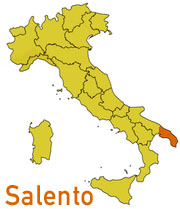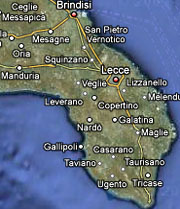Discover the beauty of Gallipoli:
an unforgettable holiday in Puglia
Gallipoli, a charming town in the Puglia region, is a real treasure waiting to be discovered. With its picturesque landscapes, rich history, fascinating architecture and stunning beaches, Gallipoli has everything you need for an unforgettable holiday. Let’s dive into the reasons why Gallipoli is the perfect destination.
1: Historical heritage
Gallipoli is a city with a rich history dating back to ancient times. The old town, set on an island and connected to the mainland by a bridge, is a living example of the past. Stroll through the narrow streets and discover historic buildings, churches and palaces. Visit Sant’Agata Cathedral, an impressive example of Baroque architecture, and explore Gallipoli Castle, which offers stunning views of the city and the sea.
2: The Old Town and its Charm
The old town of Gallipoli is a real treasure and a place where time seems to stand still. With its whitewashed houses, colourful shutters and flowered balconies, it exudes a unique charm. Stroll through the narrow streets, discover hidden squares and enjoy the relaxed atmosphere. The old town is also home to a variety of restaurants, cafés and shops where you can experience local cuisine and handicrafts.
3: Sun, Beach and Sea
Gallipoli is known for its stunning beaches and crystal clear sea. Whether you prefer
whether you prefer fine sand or rocky coves, you will find a variety of beaches to suit all tastes. Lido San Giovanni and Baia Verde are popular beaches where you can soak up the sun and enjoy the turquoise waters. Water sports such as snorkelling,
diving and boat trips offer additional opportunities to explore the sea.
4: Culinary Delights
Apulian cuisine is famous for its fresh ingredients and delicious dishes, and Gallipoli is no exception. Try the freshly caught seafood served in the local restaurants and let yourself be tempted. Let yourself be seduced by the flavours of Mediterranean cuisine. From fried seafood to homemade pasta, hundreds of veggies to best local wines, there is a wide variety of culinary delights that are a must try.
5: Cultural Events and Festivals
Gallipoli is not only known for its natural beauty, but also for its lively cultural scene. The city hosts various festivals, concerts and cultural events throughout the year. Visit the “Festival della Taranta”, a traditional music festival celebrating the Tarantella, a typical southern Italian dance. Immerse yourself in the lively atmosphere, listen to the rousing sounds and dance with the locals. Other cultural highlights include the Gallipoli Estate Festival, which features live music and theatre performances, as well as various art exhibitions and historical events.
6: Many Trips in the Surrounding Area
Gallipoli is the ideal base from which to explore the surrounding Puglia region. Take a day trip to the nearby cities of Lecce and Otranto, which fascinate with their impressive architecture and cultural heritage. Drive around the Salento peninsula, from the Ionian to the Adriatic Sea. Visit the Trulli houses in Alberobello, a UNESCO World Heritage Site, or a further afield, explore the breathtaking coastal landscapes of the Salento region and it’s inner towns and villages. The variety of excursion options offers a wealth of adventures and experiences to suit all tastes.
7: Hospitality and relaxation
The people of Gallipoli are known for their warm hospitality. Immerse yourself in the local culture culture, get to know the friendly people and experience the traditional Apulian way of life.
Whether in a cosy bed & breakfast, a stylish hotel or a traditional masseria, a rural presence, here you will find a variety of accommodation to suit your needs and needs and preferences. Enjoy the relaxed atmosphere, leave the stress of everyday life behind and everyday stress behind you and experience a relaxing holiday in the midst of idyllic surroundings.
Conclusion:
Gallipoli in the southern Puglia region of Salento is undoubtedly a destination that offers a wealth of experiences and beauty. beauty. With its rich history, charming old town, stunning beaches, delicious breathtaking beaches, delicious cuisine, cultural events and warm hospitality, Gallipoli is hospitality, Gallipoli is a place that appeals to all the senses and promises an unforgettable holiday. holiday.
Immerse yourself in the magic of this city and let yourself be enchanted by its beauty.
Gallipoli will offer you an unforgettable travel experience that will stay in your memories for a long time.
The Salento Region
Geographical location
Salento is the name of a 100 km long and 40 km wide peninsula in the extreme southeast of Italy and is often referred to as “heel” of the Italian “boot”. Administratively the peninsula is part of the Apulia region and includes the province of Lecce and part of the provinces of Taranto and Brindisi. The area is sometimes referred to as Terra d’Otranto. Older name for the Salento region are Iapygia, Messapia and Salentina.
The most important towns of the Salento region are
Lecce, Brindisi, Taranto, Gallipoli, Otranto, Maglie, Galatina and Nardò.
Story
From prehistoric times dolmens and menhirs have been preserved as remains of early farming culture. In ancient times the area was inhabited by the Messapi, an Illyrian tribe that had to defend its independence in wars against the Greek colony Taras (Taranto). Herodotus tells of a war around the year 474 v. Chr. Between Taras and the Lega peuceta (an alliance in the area around Bari), which was supported by the Lega Messapica (from Salento). In this conflict, the Messapians could after several years of war still keep the upper hand, from about 280 v. Chr. However the Roman republic in Southern Italy gained for supremacy.
Lecce had its economic and artistic heyday between 1550 and 1750. At that time the city of Lecce also received its present characteristic-baroque appearance. You can admire numerous buildings of typical Lecce Baroque style. The Roman amphitheater was exposed at the time of Mussolini partially, with valuable older buildings were demolished. 1955 State University of Lecce (now University of Salento) was founded.
Language and culture
The Italian dialect which is spoken in the Salento region, is completely different from those dialects that are spoken in the rest of Puglia.
There are also some Greek linguistic enclaves which are probably caused by a medieval migration or are even created by the ancient Greek immigration. The “Grecia Salentina” includes towns like Corigliano, Melpigniano, Castrignano dei Greci, Martano, Calimera and other villages.
In architecture, the Salento region differs from the rest of Apulia. Traditional houses are built in Greek style, i.e. they are often whitewashed and have a flat roof. The historic city centers, however, are mainly built in the Baroque style, with some typical Salentine details like the exuberant facade painting of palazzi and churches. The most popular building material was the pietra leccese, a rock with a warm reddish-yellow color, but also the yellow Carparo.
For the rest of Apulia typical historic architectural style is predominantly Romanesque unlike Salento.
Location in Italy


Click on the map to see a more detailed view.
Lecce
Region: Apulia
Lecce (LE)
Height: 49 m s.l.m.
Area: 238 km²
Population: 96,000 (2011), of which 53% women
Population density: 400 inhabitants / km².
Demonym: Leccesi
Patron: Sant’Oronzo, San Giusto and San Fortunato
Lecce (from the Latin: Lupiae) is a city in Apulia and the capital of the province of Lecce, in Salento.
In the countryside of Lecce a relatively soft, yellowish / reddish tuff “Carparo” and the slightly harder yellowish limestone “Pietra Leccese” is used, which made possible the rapid spread of the Salentine Baroque, whose numerous buildings can be admired in the city center. Because of the city’s Barocco Leccese it has also been called the “Florence of the South”. One of the most famous examples of the Baroque style of Lecce is the facade of the Basilica of Santa Croce.
Lecce History
The foundation extends to the year 1211 BC. And Malemnius is attributed, the son of Dasumnus, the first king of the Salentines. Next the legend, the city was occupied after the destruction of Troy by Lictius Idomeneus, who is said to have given it its name and opened the Greek culture. The origin of the city of Lecce is shrouded in darkness. Even less is known about the period from the 4th to the 11th century. It was a time of fighting, looting, exploitation; one of the bleakest of the Middle Ages.
Their heyday, the city, however, in the late Middle Ages. Lecce then belonged to the county Enghien and awoke slowly to new life after relegation, which they had fallen prey to the downfall of the Western Roman Empire and during the following years. The lively cultural life that prevailed in the city has always been, you have been named “Athens of Puglia” a. Although the achievements of the modern era shut by no means, but it has retained its original appearance; at first glance it can be seen that art has in Lecce deeply rooted.
Gallipoli History
Gallipoli was founded by Greek colonists as Kallipolis, which means beautiful town. 265 BC Gallipoli allied with the neighboring Greek colony of Taranto against the Romans. The resistance, however, was broken. The Conqueror declared the city a Roman municipium and stationed a garrison. In the 5th century AD vandals plundered Gallipoli. In the middle ages the city was initially norman, later Hohenstaufen before under Karl I fell to the house of Anjou in 1266. When the dynasty was sitting in the capital Naples on the throne, the Castello was built and rebuilt several times.
The Venetians were advancing in 1484 victoriously against a strong resistance of the city, but they did but destroy anything. A final battle led the pro-French Gallipoli in 1809 against the British fleet. The old town, located on a rocky island is connected by bridge to the nearby mainland new town. Gallipoli has a seat of a bishop and has a museum. The Greek name Kallipolis means “beautiful city”. Romans called the city later Gallipoli.
The historic city of Gallipoli is “riddled” in its limestone subsoil of numerous underground, ancient olive presses. Gallipoli served in the Middle Ages and later as olive oil producer for all of Europe. Back when there was no electric light, the high quality oil from Gallipoli was known for the brightest light-giving oil in the world. Even the Russian Tsar and the kings of Sweden imported olive oil from Gallipoli.
Transport, roads
Lecce is very easily accessible by the Italian Railway from Milan via Bologna, Rimini and Ancona Bari, or from Rome via Naples and Bari. The nearest airport is located about 60 km away in Brindisi, north of Lecce. By car Lecce can be reached via the well-developed and toll-free motorway SS 16 (E 55) from Bari via Brindisi. The urban core of Lecce is surrounded by a ring of 7 km in diameter, keeping away the traffic from the town.
Destination Salento
The Salento region has only lately been discovered by tourism. In Santa Cesarea Terme has beatiful villas and a palace in oriental style, a sense of “1001 Nights”. In the coast some thermal sulphurous mineral springs gushing out of caves. At the Cape Santa Maria di Leuca situated on the southernmost point of Puglia, a place of pilgrimage; here is a pilgrimage monastery. Gallípoli on the west coast of the peninsula has a unique location on an island.
Otranto is the eastern port of Italy and always an important bridgehead on the Adriatic. The historic town is perched on a rock, in the north bordering on wide sandy beaches and pine forests. The interior of the peninsula is characterized by extensive olive groves which form veritable forests and partly are many centuries old. These millions of olive trees provide the “gold of Puglia” a qualitatively very high standing olive oil, which has been exported for centuries, into the wide world. The soil is very fertile and climatic factors givel 3 harvests per year on the same field.